Biot-Granier Sensor: A Novel Strategy to Measuring Sap Flow in Trees
Abstract
:1. Introduction
2. Materials and Methods
2.1. Biot-Granier Algorithm
2.2. Biot-Granier Sensor
2.3. Experimental Setup
2.3.1. Experiment I
2.3.2. Experiment II
2.3.3. Experiment III
3. Results and Discussion
3.1. Experiment I
3.1.1. Evaluation of Sensors with the Biot-Granier Sap Flow Index Approach
3.1.2. Comparison between Biot-Granier and Conventional Granier Sensors
3.2. Experiment II
3.3. Experiment III
4. Conclusions
Author Contributions
Funding
Acknowledgments
Conflicts of Interest
References
- Stankovic, J.A.; Lee, I.; Mok, A.; Rajkumar, R. Opportunities and obligations for physical computing systems. Computer 2005, 38, 23–31. [Google Scholar] [CrossRef] [Green Version]
- Mesas-Carrascosa, F.-J.; Santano, D.V.; Meroño, J.E.; De La Orden, M.S.; García-Ferrer, A. Open source hardware to monitor environmental parameters in precision agriculture. Biosyst. Eng. 2015, 137, 73–83. [Google Scholar] [CrossRef]
- Babu, S. A software model for precision agriculture for small and marginal farmers. In Proceedings of the 2013 IEEE Global Humanitarian Technology Conference: South Asia Satellite (GHTC-SAS), Trivandrum, India, 23–24 August 2013; pp. 352–355. [Google Scholar]
- Farahani, H.J.; Howell, T.A.; Shuttleworth, W.J.; Bausch, W.C. Evapotranspiration: Progress in Measurement and Modeling in Agriculture. Trans. ASABE 2007, 50, 1627–1638. [Google Scholar] [CrossRef]
- Fuchs, S.; Leuschner, C.; Link, R.M.; Coners, H.; Schuldt, B. Calibration and comparison of thermal dissipation, heat ratio and heat field deformation sap flow probes for diffuse-porous trees. Agric. For. Meteorol. 2017, 244, 151–161. [Google Scholar] [CrossRef]
- Fernández, E.; Cohen, Y.; Ferreira, I.; Nadezhdina, N.; Testi, L.; Steppe, K. Methods to Estimate Sap Flow; ISHS Working Group on Sap Flow: Korbeek-Lo, Belgium, 2017. [Google Scholar]
- Smith, D.; Allen, S. Measurement of sap flow in plant stems. J. Exp. Bot. 1996, 47, 1833–1844. [Google Scholar] [CrossRef] [Green Version]
- Vandegehuchte, M.W.; Steppe, K. Sap-flux density measurement methods: Working principles and applicability. Funct. Plant Biol. 2013, 40, 213–223. [Google Scholar] [CrossRef] [PubMed]
- Kool, D.; Agam, N.; Lazarovitch, N.; Heitman, J.; Sauer, T.; Ben-Gal, A. A review of approaches for evapotranspiration partitioning. Agric. For. Meteorol. 2014, 184, 56–70. [Google Scholar] [CrossRef]
- Granier, A. Une nouvelle methode pour la measure du flux de seve brute dans le tronc des arbres. Ann. Sci. For. 1985, 42, 193–200. [Google Scholar] [CrossRef]
- Granier, A. Evaluation of transpiration in a Douglas-fir stand by means of sap flow measurements. Tree Physiol. 1987, 3, 309–320. [Google Scholar] [CrossRef]
- Green, S.; Clothier, B.; Jardine, B. Theory and Practical Application of Heat Pulse to Measure Sap Flow. Agron. J. 2003, 95, 1371–1379. [Google Scholar] [CrossRef]
- Granier, A.; Biron, P.; Breda, N.; Pontailler, J.-Y.; Saugier, B. Transpiration of trees and forest stands: Short and long-term monitoring using sapflow methods. Glob. Chang. Biol. 1996, 2, 265–274. [Google Scholar] [CrossRef]
- Cammalleri, C.; Rallo, G.; Agnese, C.; Ciraolo, G.; Minacapilli, M.; Provenzano, G. Combined use of eddy covariance and sap flow techniques for partition of ET fluxes and water stress assessment in an irrigated olive orchard. Agric. Water Manag. 2013, 120, 89–97. [Google Scholar] [CrossRef] [Green Version]
- Paço, T.; Pôças, I.; Cunha, M.; Silvestre, J.; Santos, F.L.; Paredes, P.; Pereira, L.S. Evapotranspiration and crop coefficients for a super intensive olive orchard. An application of SIMDualKc and METRIC models using ground and satellite observations. J. Hydrol. 2014, 519, 2067–2080. [Google Scholar] [CrossRef] [Green Version]
- Paço, T.; David, T.; Henriques, M.O.; Pereira, J.; Valente, F.; Banza, J.; Pereira, F.L.; Pinto, C.; David, J. Evapotranspiration from a Mediterranean evergreen oak savannah: The role of trees and pasture. J. Hydrol. 2009, 369, 98–106. [Google Scholar] [CrossRef]
- Sperling, O.; Shapira, O.; Cohen, S.; Tripler, E.; Schwartz, A.; Lazarovitch, N. Estimating sap flux densities in date palm trees using the heat dissipation method and weighing lysimeters. Tree Physiol. 2012, 32, 1171–1178. [Google Scholar] [CrossRef] [PubMed] [Green Version]
- Li, X.; Yang, P.; Ren, S.; Li, Y.; Liu, H.; Du, J.; Li, P.; Wang, C.; Ren, L. Modeling cherry orchard evapotranspiration based on an improved dual-source model. Agric. Water Manag. 2010, 98, 12–18. [Google Scholar] [CrossRef]
- Ferreira, I.; Silvestre, J.; Conceição, N.; Malheiro, A.C. Crop and stress coefficients in rainfed and deficit irrigation vineyards using sap flow techniques. Irrig. Sci. 2012, 30, 433–447. [Google Scholar] [CrossRef]
- Fernández, J.; Green, S.; Caspari, H.W.; Diaz-Espejo, A.; Cuevas, M.V. The use of sap flow measurements for scheduling irrigation in olive, apple and Asian pear trees and in grapevines. Plant Soil 2007, 305, 91–104. [Google Scholar] [CrossRef]
- Wilson, K.B.; Hanson, P.J.; Mulholland, P.J.; Baldocchi, D.; Wullschleger, S.D. A comparison of methods for determining forest evapotranspiration and its components: Sap-flow, soil water budget, eddy covariance and catchment water balance. Agric. For. Meteorol. 2001, 106, 153–168. [Google Scholar] [CrossRef]
- Ferreira, M.I.; Paço, T.A.; Silvestre, J.; Silva, R.M. Evapotranspiration Estimates and Water Stress Indicators for Irrigation Scheduling in Woody Plants. In Agricultural Water Management Research Trends; Nova Science Publishers: New York, NY, USA, 2008. [Google Scholar]
- Bush, S.; Hultine, K.R.; Sperry, J.S.; Ehleringer, J.R. Calibration of thermal dissipation sap flow probes for ring- and diffuse-porous trees. Tree Physiol. 2010, 30, 1545–1554. [Google Scholar] [CrossRef] [Green Version]
- Masmoudi, C.C.; Masmoudi, M.; Abid-Karray, J.; Ben Mechlia, N. Sap flow measurements in young olive trees (Olea europaea L.) cv. Chétoui under Tunisian conditions. Sci. Hortic. 2011, 129, 520–527. [Google Scholar] [CrossRef]
- Pasqualotto, G.; Carraro, V.; Menardi, R.; Anfodillo, T. Calibration of Granier-Type (TDP) Sap Flow Probes by a High Precision Electronic Potometer. Sensors 2019, 19, 2419. [Google Scholar] [CrossRef] [PubMed] [Green Version]
- Hölttä, T.; Linkosalo, T.; Riikonen, A.; Sevanto, S.; Nikinmaa, E. An analysis of Granier sap flow method, its sensitivity to heat storage and a new approach to improve its time dynamics. Agric. For. Meteorol. 2015, 211, 2–12. [Google Scholar] [CrossRef]
- Lubczynski, M.; Chavarro-Rincon, D.; Roy, J. Novel, cyclic heat dissipation method for the correction of natural temperature gradients in sap flow measurements. Part 1. Theory and application. Tree Physiol. 2012, 32, 894–912. [Google Scholar] [CrossRef] [PubMed] [Green Version]
- Fernández, J. Plant-based sensing to monitor water stress: Applicability to commercial orchards. Agric. Water Manag. 2014, 142, 99–109. [Google Scholar] [CrossRef] [Green Version]
- Lu, P.; Urban, L.; Zhao, P. Granier’s thermal dissipation probe (TDP) method for measuring sap flow in trees: Theory and practice. Acta Bot. Sin. 2004, 46, 631–646. [Google Scholar]
- Incropera, F.P.; DeWitt, D.P.; Bergman, T.L.; Lavine, A.S. Fundamentals of Heat and Mass Transfer, 6th ed.; John Wiley & Sons, Limited: Hoboken, NJ, USA, 2007; ISBN 9780471457282. [Google Scholar]
- Siqueira, J.; Paço, T.; Silvestre, J.; Santos, F.L.; Falcao, A.; Pereira, L.S. Generating fuzzy rules by learning from olive tree transpiration measurement – An algorithm to automatize Granier sap flow data analysis. Comput. Electron. Agric. 2014, 101, 1–10. [Google Scholar] [CrossRef]
- Siqueira, J.D.M.; Da Silva, J.M.; Paço, T. Smart orchard irrigation system. In Proceedings of the 2015 Conference on Design of Circuits and Integrated Systems (DCIS), Estoril, Portugal, 25–27 November 2015; pp. 1–6. [Google Scholar]
- Schuepp, P.H.; Leclerc, M.Y.; MacPherson, J.I.; Desjardins, R.L. Footprint prediction of scalar fluxes from analytical solutions of the diffusion equation. Bound. Layer Meteorol. 1990, 50, 355–373. [Google Scholar] [CrossRef]
- Siqueira, J.M. Sistema de Controlo Inferencial com Dispositivos Sensoriais Direcionados para o Uso Eficiente da Água na Agricultura. Ph.D. Thesis, Instituto Superior de Agronomia, Instituto Superior de Agronomia—Universidade de Lisboa, Lisboa, Portugal, 2019; p. 155. [Google Scholar]
- Rabbel, I.; Diekkrüger, B.; Voigt, H.; Neuwirth, B. Comparing ∆Tmax Determination Approaches for Granier-Based Sapflow Estimations. Sensors 2016, 16, 2042. [Google Scholar] [CrossRef] [Green Version]
- Ferreira, M.I.; Katerji, N.; Ferreira, I. Is stomatal conductance in a tomato crop controlled by soil or atmosphere? Oecologia 1992, 92, 104–107. [Google Scholar] [CrossRef]
- Paço, T.A. Modelação da Evapotranspiração em Cobertos Descontínuos Programação da Rega em Pomar de Pessegueiro. Ph.D. Thesis, Instituto Superior de Agronomia, Universidade de Lisboa, Lisboa, Portugal, 2003. [Google Scholar]
- Fernández, J.; Duran, P.J.; Palomo, M.J.; Diaz-Espejo, A.; Chamorro, V.; Girón, I. Calibration of sap flow estimated by the compensation heat pulse method in olive, plum and orange trees: Relationships with xylem anatomy. Tree Physiol. 2006, 26, 719–728. [Google Scholar] [CrossRef] [PubMed] [Green Version]
- Rogiers, S.Y.; Greer, D.H.; Hutton, R.J.; Clarke, S.J. Transpiration efficiency of the grapevine cv. Semillon is tied to VPD in warm climates. Ann. Appl. Biol. 2010, 158, 106–114. [Google Scholar] [CrossRef]
- Blanco-Cipollone, F.; Lourenço, S.; Silvestre, J.; Conceição, N.; Moñino, M.J.; Vivas, A.; Ferreira, I. Plant Water Status Indicators for Irrigation Scheduling Associated with Iso- and Anisohydric Behavior: Vine and Plum Trees. Horticulturae 2017, 3, 47. [Google Scholar] [CrossRef]
- Heilman, J.; McInnes, K.; Savage, M.; Gesch, R.; Lascano, R. Soil and canopy energy balances in a west Texas vineyard. Agric. For. Meteorol. 1994, 71, 99–114. [Google Scholar] [CrossRef]



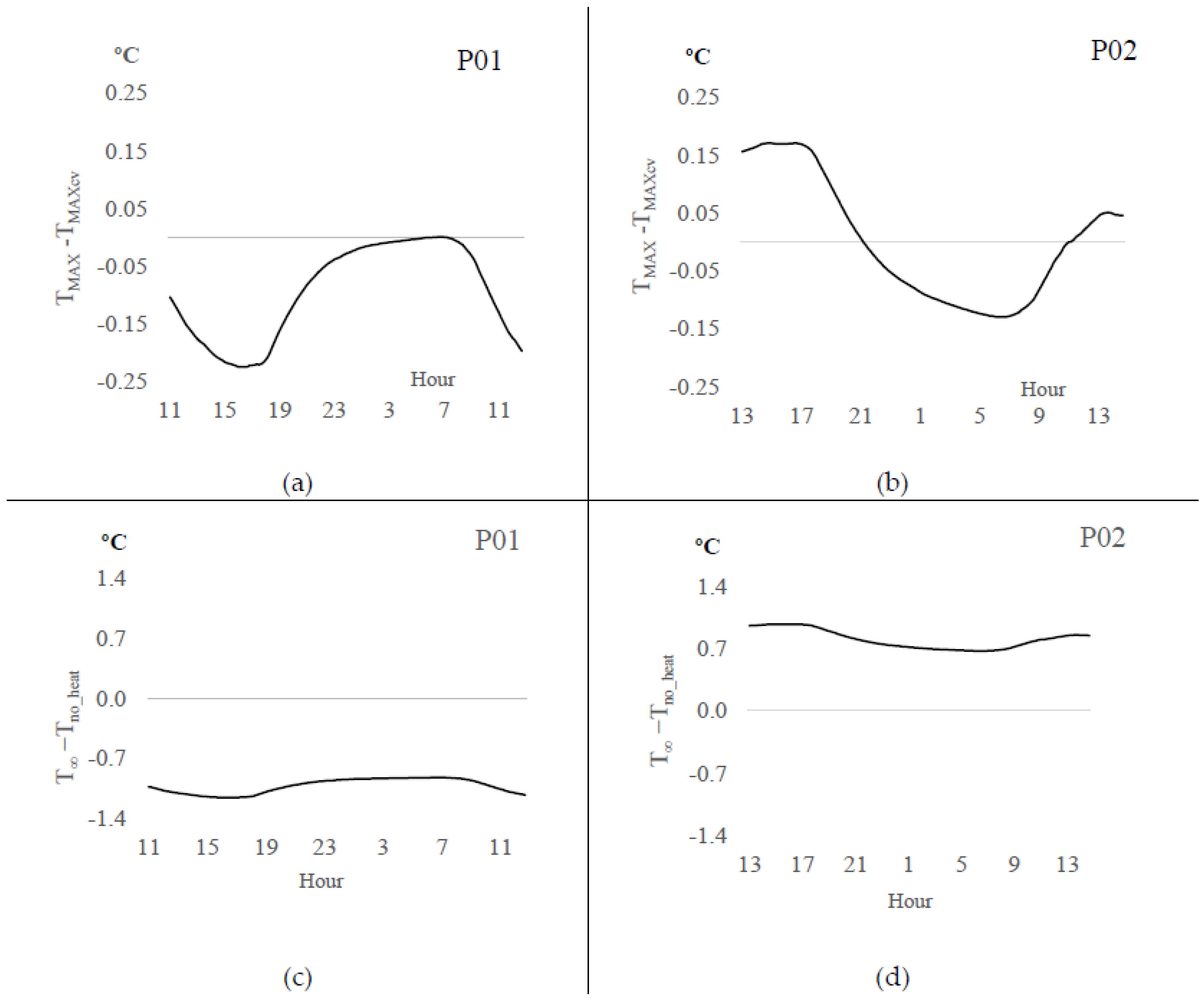
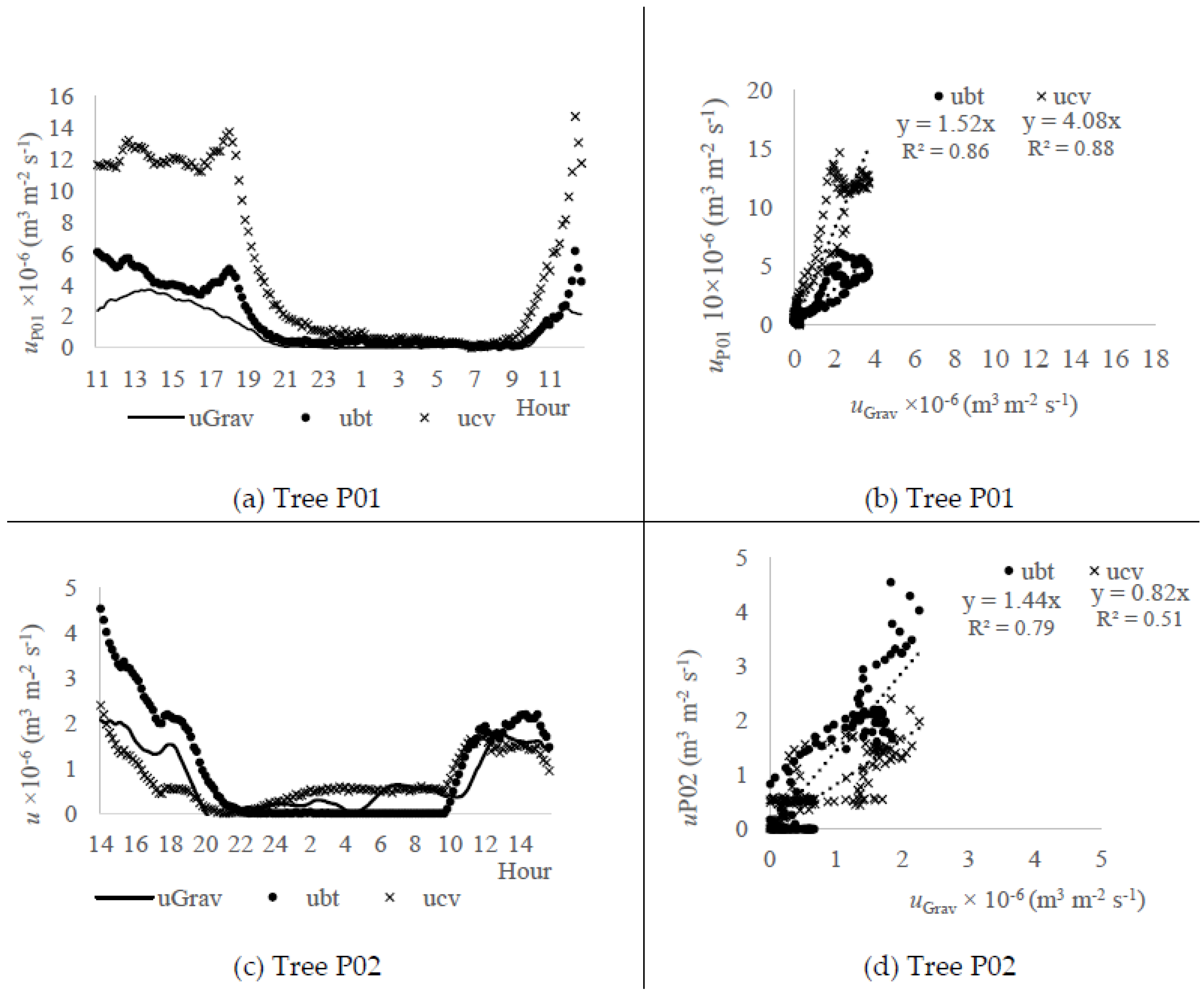
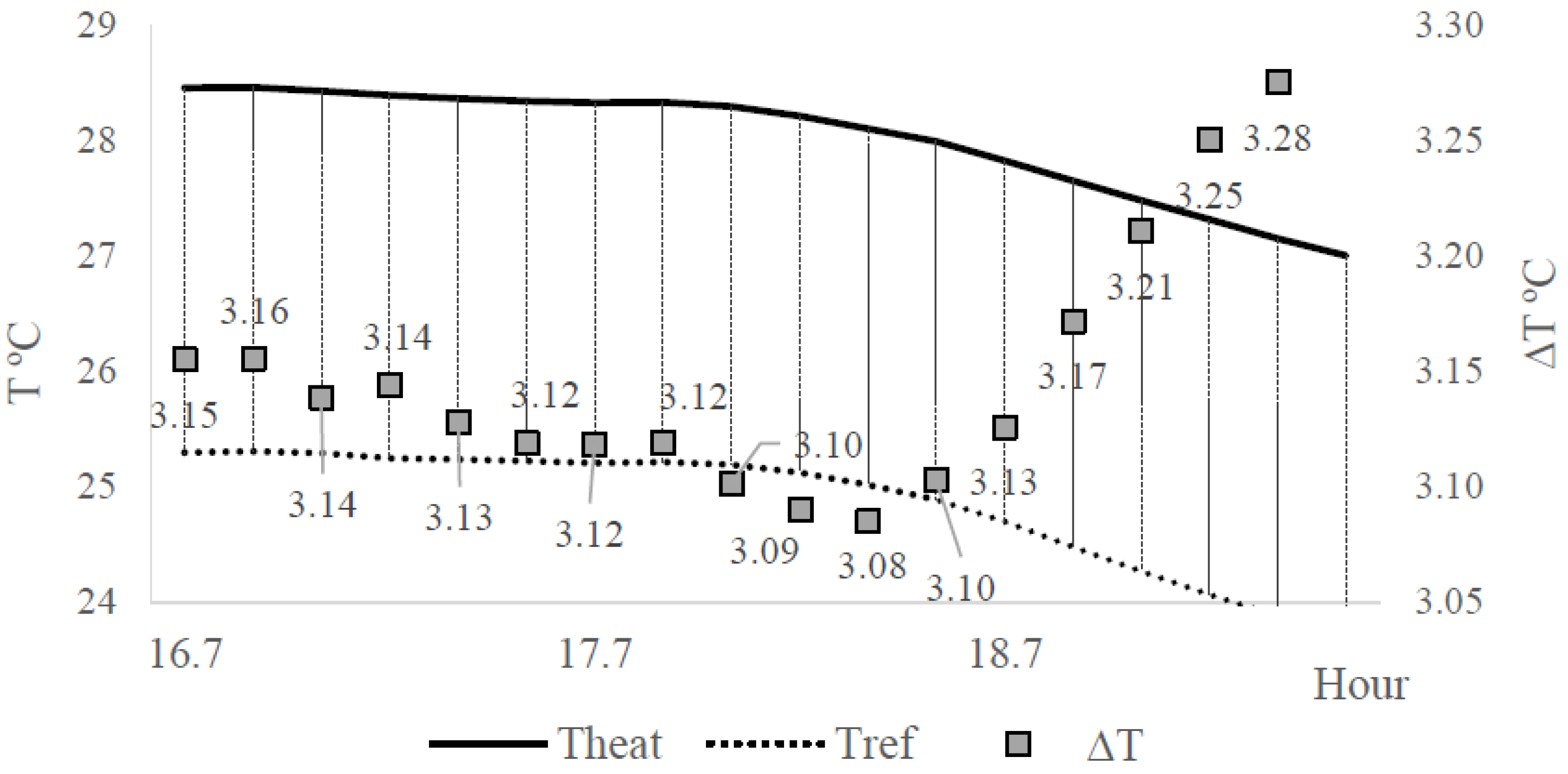



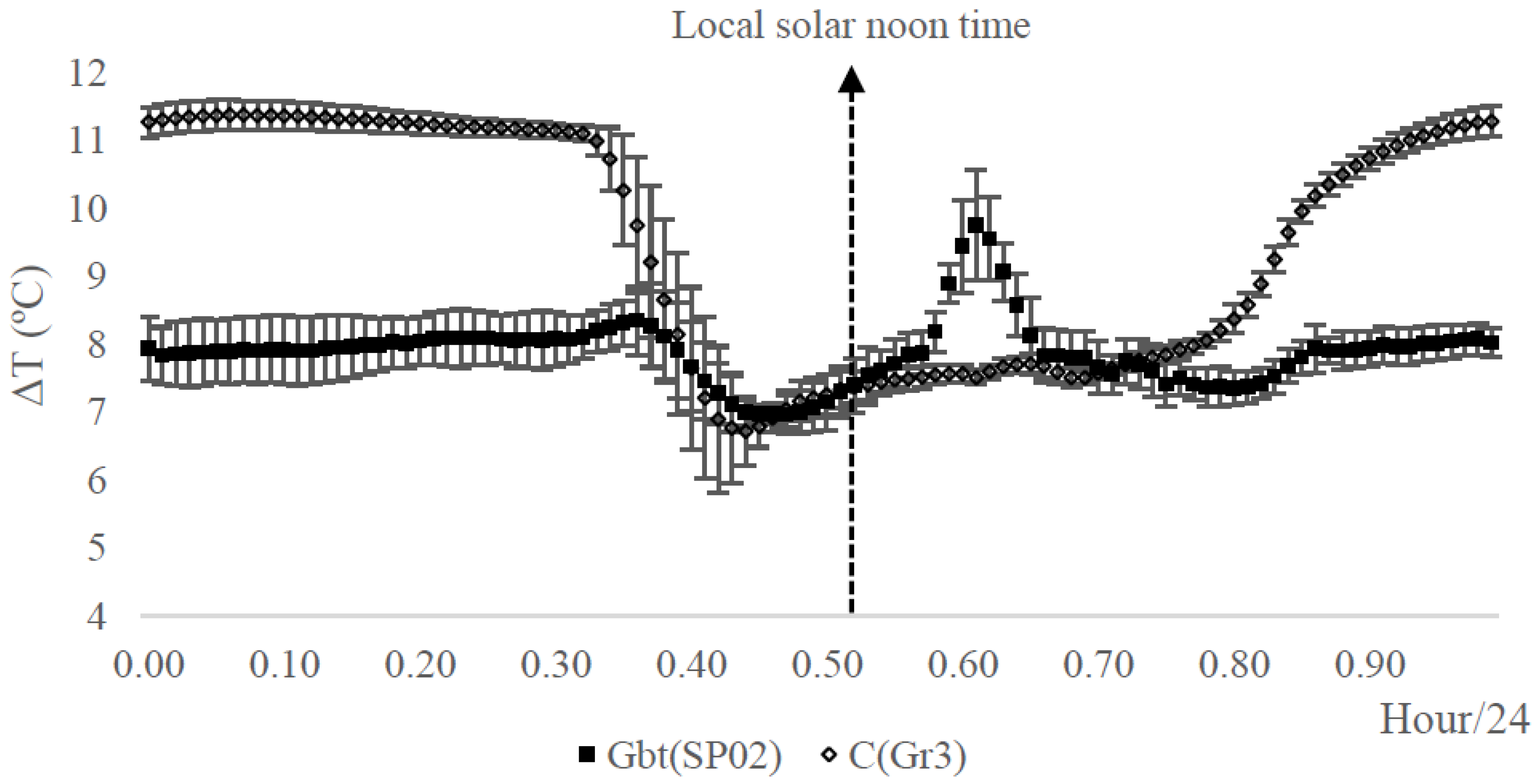


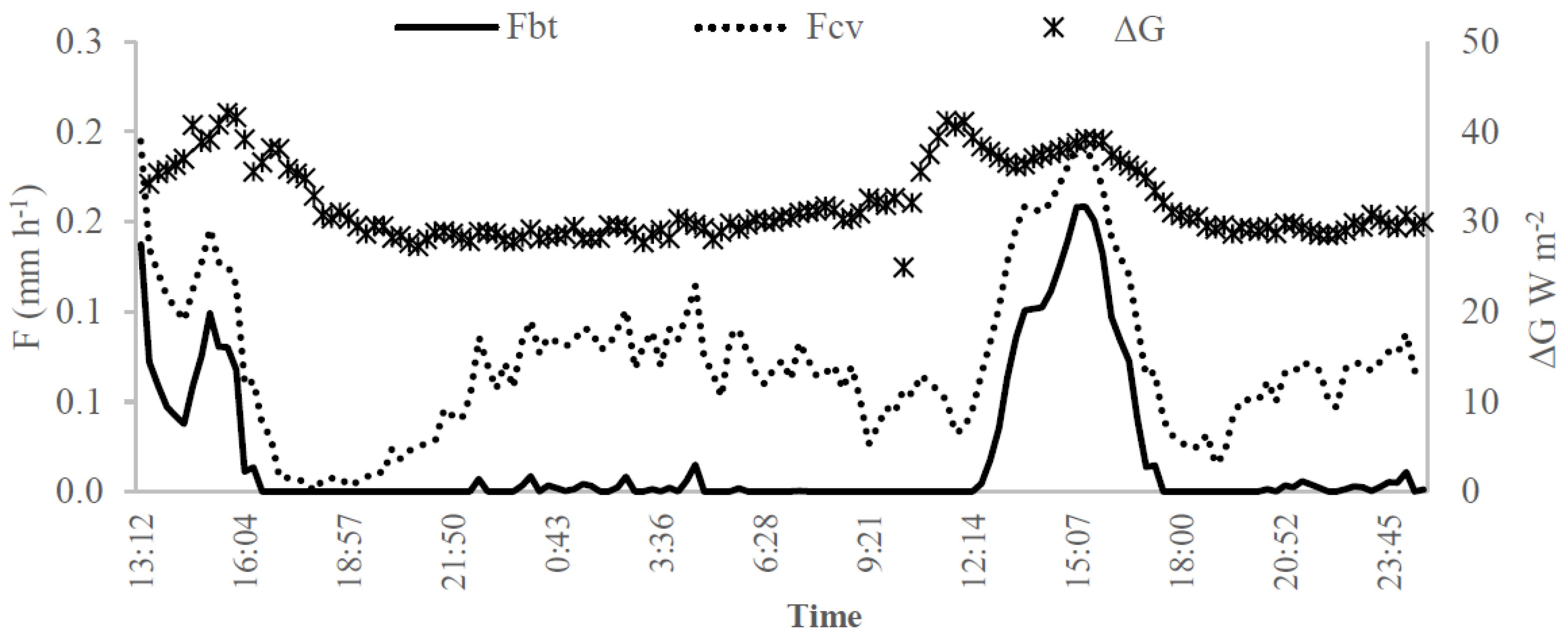
| Criteria | Conventional Granier Approach (Gcv) | Biot-Granier Approach (Gbt) |
|---|---|---|
| Sensing component | Type T Thermocouple (Copper/Constantan) | Thermistor |
| Wide range of temperature sensing (−200 °C to 350 °C) | Narrow range of sensing (−55 °C to 150 °C) | |
| Requires a high-resolution measuring system such as a voltmeter to measure the output voltage. | Requires an external voltage to operate as a measuring device. | |
| Difficult construction. | Easy construction. | |
| The voltage generated at different temperatures is relatively low (around 43 µV/°C). Thus, amplification is required. | Resistance based measurement process—a voltage divider set with a reference resistor tied to a reference voltage usually is enough. Thus, amplification is not required. | |
| Heating component | Constantan Wire (range 14 to 20 Ω) | Nickel-chrome Wire (range 30 to 40 Ω) |
| Operational Features | ||
| Type of Measurement | Differential Temperature | Absolute Temperature |
| Temperature sensing location | Inner of the heating tube. | Outer of heating tube, on the needle tip. |
| Olive Trees | 1 ATK (cm2) | Azimuth | 2 h|s (cm) | 3 p|s (cm) |
|---|---|---|---|---|
| P01 | 24 | N | 26 | 86 |
| P02 | 18 | N | 37 | 120 |
| C01 | 21 | N | 30 | 100 |
| C02 | 21 | N | 40 | 120 |
| 1 Exp | Description | Period (Days of Year) | Objective | Sensor Sets |
|---|---|---|---|---|
| I | Potted olive trees in a greenhouse (variety “Galega”) | 69 to 110 (2018) | comparison with the gravimetric method and commercial sap flow sensors in the greenhouse | P01, P02, C01, C02 |
| II | Vineyard (variety “Tempranillo”) | 201 to 240 (2017) | comparison with commercial sap flow sensors in the experimental field | SP04, Gr3 |
| III | Vineyard (variety “Galego Dourado”) | 245 to 305 (2016) | comparison with eddy covariance, soil water content and soil heat flux | SP32L |
© 2020 by the authors. Licensee MDPI, Basel, Switzerland. This article is an open access article distributed under the terms and conditions of the Creative Commons Attribution (CC BY) license (http://creativecommons.org/licenses/by/4.0/).
Share and Cite
M. Siqueira, J.; A. Paço, T.; Machado da Silva, J.; C. Silvestre, J. Biot-Granier Sensor: A Novel Strategy to Measuring Sap Flow in Trees. Sensors 2020, 20, 3538. https://doi.org/10.3390/s20123538
M. Siqueira J, A. Paço T, Machado da Silva J, C. Silvestre J. Biot-Granier Sensor: A Novel Strategy to Measuring Sap Flow in Trees. Sensors. 2020; 20(12):3538. https://doi.org/10.3390/s20123538
Chicago/Turabian StyleM. Siqueira, Jucilene, Teresa A. Paço, José Machado da Silva, and José C. Silvestre. 2020. "Biot-Granier Sensor: A Novel Strategy to Measuring Sap Flow in Trees" Sensors 20, no. 12: 3538. https://doi.org/10.3390/s20123538






